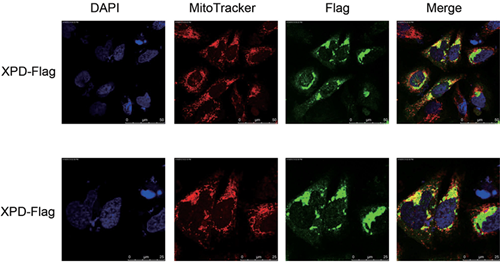XPD Protects the Mitochondrial Genome from Oxidative DNA Damage
Mitochondria are essential organelles of the eukaryotic cell and the main supply of energy via respiration, the respiratory chain oxidative phosphorylation process is accompanied by a high level of production of reactive oxygen species (ROS).
Mitochondrial genome is lack of histone protection, so it is vulnerable to ROS attack and damage, the accumulation of the mutations have been closely linked to a variety of human diseases, such as neural degenerative diseases, diabetes, cardiovascular disease and cancer, etc. A lot of molecular mechanisms about nuclear genome DNA damage repair have been reported, while mitochondria get through which key genes or pathways to maintain the stability of the genome is still unclear.
Xeroderma pigmentosum group D (XPD) encodes an ATP-dependent helicase that plays essential roles in both transcription and nucleotide excision repair of nuclear DNA.
Recently, ZHAO Yongliang’s group from Key Laboratory of Genomic and Precision Medicine, Chinese Academy of Sciences makes important progress in the study of mitochondrial oxidative damage repair, the study provides the first evidence that XPD is localized in the inner membrane of mitochondria, and demonstrates that XPD plays crucial roles in protecting mitochondrial genome stability by facilitating an efficient repair of oxidative DNA damage in mitochondria. Related research is published in the Nucleic Acids Research, Frontier journal in the field of Nucleic Acids Research.
The study found that treatment the cells with oxidative stress led to an enhanced recruitment of XPD into mitochondrial compartment. Function experiment further proved that XPD defects lead to an obvious decrease on oxidative damage repair ability of mitochondrial genome, showing the mitochondrial genome mutation rate or missing levels increased significantly.
Covering experiments further confirmed the XPD protein helicase activity plays a key role in the exercise of their functions. In addition, through the mitochondrial precipitation and mass spectrometry analysis, the study confirmed the interaction between XPD protein and mitochondrial translation extension factor TUFM. XPD through its interaction with mitochondrial TUFM plays a crucial role in the maintenance of mitochondrial stability by protecting the mtDNA from endogenous and exogenous oxidative DNA damage accumulation.
The study is supported by National Basic Research Program of China (973) and National Natural Science Foundation of China.

Co-localization of XPD protein with mitochondria in U2OS cells (Image by ZHAO Yongliang's group)